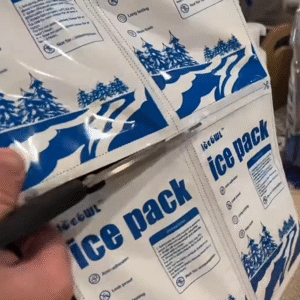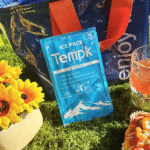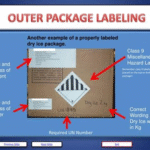Toko Paket Es Kering Terdekat: Bagaimana Anda Memilih Yang Tepat?
Perkenalan
Jika Anda membutuhkan toko terdekat bungkus es kering cepat, panduan ini membantu Anda memilih ukuran yang tepat, tetap aman selama transportasi, dan menjaga barang pada suhu target. Anda akan mendapatkan metode pengukuran sederhana, daftar periksa keselamatan, Dan 2025 tips membeli yang sesuai dengan timeline dan anggaran Anda. Gunakan alat di bawah ini untuk memilih format makanan yang ideal, Sampel lab, berkemah, atau pendinginan darurat tanpa menebak-nebak.
-
Pengecer mana yang menjual toko terdekat bungkus es kering dan apa yang harus ditanyakan di konter
-
Berapa banyak toko terdekat bungkus es kering Anda butuhkan untuk durasi yang lebih dingin
-
Bagaimana cara menanganinya toko terdekat bungkus es kering aman di mobil dan ruang kecil
-
Kapan harus memilih pelet, blok, atau hibrida toko terdekat bungkus es kering
-
Bagaimana toko terdekat bungkus es kering bandingkan dengan kemasan gel dan es batu yang dapat digunakan kembali
-
2025 penggerak harga dan ketersediaan toko terdekat bungkus es kering
Di mana Anda dapat membeli paket es kering di toko terdekat hari ini?
Jawaban Langsung
Kebanyakan pembeli menemukan toko es kering terdekat di toko grosir besar, gerai pesta dan minuman, apotek yang dipilih, dan toko perangkat keras. Tanyakan layanan pelanggan untuk ketersediaan, format (pelet vs.. blok), dan ukuran tas. Banyak lokasi menyimpan paket di pendingin ruang belakang untuk keamanan. Bawalah sarung tangan atau handuk berinsulasi untuk menanganinya, dan konfirmasi aturan pengambilan (beberapa toko membatasi jumlah demi keamanan atau memerlukan pemeriksaan identitas).
Penjelasan yang diperluas
Dari sudut pandang Anda, kecepatan itu penting: kamu mau toko terdekat bungkus es kering Anda dapat mengambilnya dalam beberapa menit. Telepon dulu dan ajukan dua pertanyaan: “Apakah Anda mempunyai kantong es kering atau pelet lepas?” dan “Ukuran apa yang tersedia?” Untuk perjalanan darat atau pengiriman jarak jauh, satu perhentian yang menjual kemasan dan pendingin busa dapat menghemat waktu. Jika toko kelontong sedang keluar, toko pesta terdekat yang menjual tong atau kartrid CO₂ sering kali menyediakan stok toko terdekat bungkus es kering demikian juga. Saat hari libur dan gelombang panas, persediaan semakin terbatas—datanglah lebih awal dan pertimbangkan dua tas yang lebih kecil daripada satu blok besar untuk meningkatkan kontak permukaan di pendingin Anda.
Berapa ukuran paket es kering toko terdekat yang sebaiknya Anda pilih?
Detail
Ketika beban Anda kecil dan waktu singkat, pelet memberikan lebih banyak area kontak dan pull-down lebih cepat; Blok bertahan lebih lama. Untuk barang rapuh (MISALNYA., buah beri atau kotak vaksin), letakkan karton atau penyangga handuk di antaranya toko terdekat bungkus es kering dan produk untuk mencegah kerusakan akibat pembekuan. Untuk aturan maskapai atau parsel, periksa persyaratan ventilasi kontainer; jangan pernah menggunakan pendingin kedap udara dengan es kering.
| Jenis paket & Menggunakan | Format Khas | Perilaku Tahan Waktu | Apa Artinya Bagi Anda |
|---|---|---|---|
| Pelet/"nasi" untuk pendinginan cepat | Butiran kecil | Pendinginan awal lebih cepat, total durasi yang lebih pendek | Yang terbaik adalah ketika Anda harus bersantai dengan cepat sebelum berkendara singkat |
| Paket “bata” sedang | Paket terbungkus | Kontak dan durasi permukaan yang seimbang | Pilihan serba bagus untuk perjalanan sehari |
| Blok padat | 5–10 pon blok | Mulai lebih lambat, durasi terpanjang | Pilih waktu tunggu semalaman atau beberapa hari |
Tips dan saran praktis
-
Penjemputan bahan makanan cepat: Mintalah “es kering dalam kantong” atau “es kering kemasan” di layanan pelanggan; banyak toko menyimpan tas di belakang konter.
-
Untuk perjalanan jauh: Gunakan busa atau pendingin keras dengan celah ventilasi kecil; tempat toko terdekat bungkus es kering di atas sehingga udara dingin tenggelam.
-
Untuk makanan rapuh: Tambahkan lapisan bergelombang untuk menghindari pembekuan kontak; periksa setiap 60–90 menit.
Kasus nyata: Katering akhir pekan digunakan 10 lb gaya pelet toko terdekat bungkus es kering dalam pendingin 45 liter untuk pengiriman jalan raya 6 jam. Dengan sekat karton dan ventilasi berkala, makanan penutup tiba dalam keadaan utuh tanpa kerusakan kristal es.
Bagaimana Anda mengangkut bungkusan es kering di toko terdekat dengan aman?
Jawaban Langsung
Ventilasi tidak dapat dinegosiasikan saat memindahkan kantong es kering di toko terdekat. Gas karbon dioksida menggantikan oksigen; memecahkan jendela mobil dan menghindari bagasi yang tertutup rapat. Kenakan sarung tangan terisolasi, jangan pernah menyimpan paket dalam wadah kedap udara, dan jauhkan dari jangkauan anak-anak dan hewan peliharaan. Tempatkan paket di tempat yang lebih dingin terakhir, meninggalkan celah ventilasi, dan kencangkan pendingin untuk mencegah perpindahan.
Penjelasan yang diperluas
Bayangkan es kering sebagai sumber CO₂ yang dilepaskan secara perlahan. Di mobil kecil atau van, aliran udara segar mengurangi risiko dan membuat Anda tetap nyaman. Jendela yang sedikit terbuka dan pendingin berventilasi mencegah penumpukan tekanan. Jika Anda mencium tidak ada bau, itu normal—CO₂ tidak berbau; mengandalkan ventilasi yang baik, tidak berbau. Dengan toko terdekat bungkus es kering, "pengaturan aman" Anda sederhana: tutup yang berventilasi, lapisan penyangga di atas makanan, dan rencana mengemudi yang menghindari lonjakan panas kabin. Jika Anda berhenti lebih dari 10 menit, periksa kembali ventilasi dan ventilasi pendingin.
Penanganan yang aman dan APD untuk bungkus es kering di toko terdekat
Detail
Sarung tangan berinsulasi atau handuk tebal melindungi dari luka bakar dingin. Pelindung mata membantu memecahkan balok menjadi potongan-potongan kecil. Hindari menempatkan toko terdekat bungkus es kering langsung di lantai mobil logam; gunakan karton untuk mengurangi pengembunan dan mencegah lengket. Simpan bungkusan dalam posisi tegak di dalam pendingin, dan jangan menutup tutupnya—gas perlu jalan keluar.
| Langkah Keamanan | Mengapa itu penting | Cara Sederhana | Manfaat bagi Anda |
|---|---|---|---|
| Ventilasi kendaraan | CO₂ menggusur oksigen | Retak jendela 2–3 cm | Mengurangi sakit kepala, membuat Anda tetap waspada |
| Ventilasi pendingin | Tekanan gas meningkat | Kendurkan kaitnya atau gunakan penutup berventilasi | Mencegah deformasi atau tutup pecah |
| Gunakan pelindung tangan | Risiko Frostbite | Sarung tangan berinsulasi atau handuk terlipat | Pemuatan dan penataan ulang yang aman |
Tips dan saran praktis
-
Selama pemberhentian yang lama: Pindahkan pendingin ke tempat yang teduh, tempat yang berventilasi dan jaga agar tutupnya tetap berventilasi.
-
Di rumah: Membiarkan toko terdekat bungkus es kering menyublim dengan aman, area berventilasi jauh dari jangkauan anak-anak dan hewan peliharaan.
-
Di lift atau lemari: Hindari penggunaan—pilih terbuka, ruang lapang sebagai gantinya.
Kasus nyata: Pengemudi lab keliling menyesuaikan ventilasi dan menggunakan pendingin busa dengan a 3 celah mm saat mengangkut toko terdekat bungkus es kering selama empat jam. Pembacaan CO₂ tetap berada pada kisaran aman, dan tutup pendingin tidak pernah menonjol.
Apakah toko terdekat menyimpan kantong es kering untuk menyimpan makanan, vaksin, atau sampel cukup dingin?
Jawaban Langsung
Ya—bila ukurannya benar, Paket es kering di toko terdekat dapat menjaga isinya jauh di bawah titik beku, bahkan pada suhu 0–5°C atau lebih dingin selama berjam-jam hingga berhari-hari. Kuncinya adalah mencocokkan massa paket dengan ukuran yang lebih dingin, suhu sekitar, dan target waktu tunggu, ditambah menggunakan lapisan penyangga untuk mencegah kerusakan akibat pembekuan langsung pada barang sensitif.
Penjelasan yang diperluas
Makanan menginginkan konsistensi; sampel laboratorium seringkali memerlukan kondisi yang sangat dingin. Pelet dan kemasan kecil menyediakan penarikan cepat untuk belanjaan cepat; blok membawamu semalaman. Untuk melindungi produk dan barang-barang halus, tempat kertas, kardus, atau handuk di atasnya toko terdekat bungkus es kering. Untuk target di bawah nol, lebih banyak paket massa membantu. Untuk keju atau coklat, strategi campuran—satu bungkus kecil di dekat pembatas tipis—seringkali menghindari retaknya permukaan.
Perkirakan waktu tunggu vs. suhu sekitar
Detail
Sebagai aturan praktis, mulai dengan 5–10 pon toko terdekat bungkus es kering untuk pendingin 35–50 liter selama sehari penuh, lalu sesuaikan dengan iklim dan seberapa sering Anda membuka tutupnya. Hari-hari yang lebih panas, pendingin yang lebih besar, dan pembukaan tutup yang sering membutuhkan lebih banyak massa. Gunakan pelet untuk mendinginkan dengan cepat, blok untuk durasi, atau hibrida.
| Gunakan kasing | Rentang Sekitar | Mulai Paket Misa | Apa Artinya Bagi Anda |
|---|---|---|---|
| Makanan beku perjalanan sehari | 20–28°C | 5 pon dalam 35–45 qt | Beku sampai penghujung hari |
| Berkemah semalaman | 18–25°C | 8–12 pon dalam 45–60 qt | Beku saat sarapan |
| Pengiriman multi-stop | 25–32°C | 10–15 pon dalam 50–70 qt | Buffer agar tutup sering terbuka |
Tips dan saran praktis
-
Untuk muatan campuran: Simpan daging mentah di bawah pembatas dan toko terdekat bungkus es kering di atas pembatas.
-
Untuk peralatan laboratorium: Dinginkan terlebih dahulu pendingin selama 10–15 menit dengan segenggam pelet sebelum dimasukkan.
-
Untuk menghasilkan: Gunakan penyangga bernapas untuk menghindari pembekuan kontak.
Kasus nyata: Seorang pembuat coklat berpasangan 5 lb blok dengan penyangga handuk dan dua kantong pelet kecil. Setelah enam jam pengiriman kota, bonbons tetap mengkilap tanpa mekar.
Bagaimana cara menyimpan kantong es kering di sekitar dibandingkan dengan kantong gel dan es yang dapat digunakan kembali?
Jawaban Langsung
Toko terdekat adalah paket es kering memberikan suhu yang lebih rendah dan waktu tahan lebih lama per pon dibandingkan kemasan gel, namun memerlukan ventilasi dan sarung tangan. Paket gel lebih aman untuk target di atas titik beku, sementara yang dapat digunakan kembali nyaman untuk sering digunakan, perjalanan singkat. Pilih es kering saat Anda memerlukan kondisi beku asli atau penarikan cepat.
Penjelasan yang diperluas
Pikirkan pendinginan seperti pemilihan alat: es kering adalah alat yang ampuh untuk membekukan; gel dan dapat digunakan kembali adalah perkakas tangan untuk bersantai. Jika produk Anda tidak membeku, gel bersinar. Jika Anda harus menyimpan barang sekokoh mungkin atau mencapai suhu di bawah −18°C dengan cepat, toko terdekat bungkus es kering menang. Anda bahkan dapat menggabungkannya: paket es kering kecil untuk penarikan cepat ditambah paket gel untuk memperlancar perubahan suhu di permukaan produk.
Kapan tidak menggunakan kantong es kering di toko terdekat
Detail
Lewati es kering untuk barang-barang yang rusak akibat suhu dingin yang dalam (sayuran berdaun hijau, beberapa obat), di ruang yang tidak berventilasi, atau jika peraturan memerlukan zat pendingin khusus. Jika Anda hanya membutuhkan 1–2 jam pada suhu lemari es, paket gel lebih sederhana dan tetap efektif.
| Opsi Pendinginan | Suhu Sasaran | Pro | Kesimpulan Anda |
|---|---|---|---|
| Toko terdekat adalah paket es kering | Di bawah nol hingga sangat beku | Pull -down cepat, durasi yang lama | Terbaik untuk barang beku dan pengiriman kering |
| Paket gel | 0–8 ° C. | Aman untuk barang-barang halus | Ideal untuk dingin tetapi tidak beku |
| Batu bata yang dapat digunakan kembali | 0–10°C | Tidak ada pembelian setiap perjalanan | Cocok untuk lari jarak pendek rutin |
Tips dan saran praktis
-
Beban hibrida: Gunakan satu tas kecil toko terdekat bungkus es kering untuk memulai, lalu andalkan gel untuk menghindari pembekuan berlebih.
-
Untuk pengobatan: Periksa rentang penyimpanan label; jika tertulis “jangan dibekukan,” pilih gel.
-
Untuk bunga: Hindari es kering; gunakan paket air dingin sebagai gantinya.
Kasus nyata: Layanan persiapan makanan mengurangi pembusukan dengan menggabungkan keduanya 2 lb toko terdekat bungkus es kering dengan empat paket gel dan pembagi bergelombang, menjaga makanan pembuka tetap kencang tanpa embun beku.
Berapa ukuran dan jumlah paket es kering toko terdekat yang Anda butuhkan?
Jawaban Langsung
Perencana cepat berhasil: ukuran lebih dingin + panas sekitar + tahan waktu + seberapa sering Anda membuka tutupnya. Mulailah dengan 0,2–0,3 pon toko terdekat bungkus es kering per liter volume dingin selama sehari penuh dalam cuaca sedang, kemudian sesuaikan dengan panas atau akses yang sering.
Penjelasan yang diperluas
Anda ingin massa yang cukup untuk bertahan lebih lama dari kebocoran panas. Aturan di bawah ini mengutamakan kesederhanaan dan kecepatan dibandingkan detail teknis. Untuk pendingin yang lebih besar, gunakan setidaknya satu blok ditambah pelet untuk mengisi kekosongan. Untuk pembukaan yang sering, tambahkan 25–50% lebih banyak toko terdekat bungkus es kering untuk tetap aman.
“Dry Ice Pack Picker” — daftar periksa interaktif cepat
Salin daftar periksa ini ke dalam catatan dan tandai pilihan Anda:
-
Ukuran yang lebih dingin: <35 qt / 35–50 qt / 50–70 qt / >70 qt
-
Tahan target waktu: 6 H / 12 H / 24 H / 36+ H
-
Prakiraan lingkungan: Dingin (<22° C.) / hangat (22–28°C) / panas (>28° C.)
-
Bukaan tutup per jam: 0–1 / 2–4 / 5+
-
Jenis beban: beku yang kuat / beku halus / dingin saja
Misa awal yang direkomendasikan:
-
35–50 qt, 24 H, cuaca hangat, 2–4 pembukaan/jam → 8–12 pon toko es kering terdekat
-
50–70 qt, 24 H, cuaca panas, 5+ bukaan/jam → 15–20 pon toko es kering terdekat
-
Menambahkan 25% untuk barang halus (gunakan buffering ekstra)
Pembantu estimasi sederhana (kodesemu)
Tips dan saran praktis
-
Isi kekosongan: Kemas barang dengan rapat; celah udara membuang dingin.
-
Layering: Produk di bagian bawah, penyangga, Kemudian toko terdekat bungkus es kering di atas.
-
Pos pemeriksaan: Rencanakan pemeriksaan tutup setiap 2–3 jam untuk menyesuaikan buffer.
Kasus nyata: Seorang kru penangkapan ikan menggunakan kodesemu untuk a 60 qt lebih dingin dalam cuaca panas dengan akses yang sering. Alat ini menyarankan ~18 lb; mereka gunakan 16 lb ditambah penyangga handuk dan dikembalikan dengan fillet yang keras dan tidak meleleh.
Berapa harga paket es kering di toko terdekat 2025, dan apa yang mempengaruhi harga?
Jawaban Langsung
Harapkan harga bervariasi menurut wilayah, musim, dan memformat. Anda akan sering melihat harga per pon dengan diskon untuk tas yang lebih besar atau multi-paket. Blok mungkin memiliki premi yang kecil untuk waktu penahanan yang lebih lama; pelet dan kemasan kecil menukar sedikit durasi untuk pendinginan yang lebih cepat dan biaya per-stop yang lebih rendah.
Penjelasan yang diperluas
Di dalam 2025, pasokan CO₂ lokal dan biaya energi tetap menjadi pendorong terbesar. Gelombang panas, akhir pekan yang panjang, dan musim acara dapat memperketat stok toko terdekat bungkus es kering. Jika Anda sensitif terhadap harga, hubungi dua toko, tanyakan “ukuran dan harga tas saat ini,” dan tanyakan apakah mereka akan menyimpan paket di konter untuk diambil pada hari yang sama. Membeli sedikit lebih banyak dari yang Anda kira Anda perlukan sering kali lebih murah daripada perjalanan darurat kedua.
Penggerak harga yang dapat Anda kelola
Detail
Anda tidak dapat mengontrol penangkapan atau pengiriman CO₂ regional, tapi kamu bisa membuat rencana. Berbelanja di awal hari, gunakan pendingin berukuran tepat, dan mengurangi bukaan tutup. Untuk rute reguler, simpan catatan sederhana tentang berapa banyak toko terdekat bungkus es kering Anda menggunakan suhu berapa untuk menyempurnakan pembelian di masa mendatang.
| Pengemudi | Apa yang Berubah | Langkah Anda | Manfaat praktis |
|---|---|---|---|
| Musim/hari libur | Lonjakan permintaan | Beli lebih awal atau pesan | Ketersediaan yang lebih baik |
| Format | Blok vs pelet | Cocokkan dengan durasi | Hindari membeli secara berlebihan |
| Jenis toko | Penjual kelontong vs pesta/perangkat keras | Telepon dulu | Lebih sedikit perjalanan yang sia-sia |
Tips dan saran praktis
-
Minta “stok kembali”: Banyak toko yang menyimpannya toko terdekat bungkus es kering di belakang konter.
-
Reservasi melalui telepon: Beberapa pengecer akan menyediakan tas berlabel untuk diambil.
-
Lacak penggunaan Anda: Simpan catatan cepat per perjalanan; optimalkan lain kali.
Kasus nyata: Seorang fotografer mengetahui bahwa toko perlengkapan pesta di dekat tempat tersebut mengisi kembali stoknya setiap pagi. Menelepon terlebih dahulu mengamankan dua paket blok selama gelombang panas di seluruh kota.
Keberlanjutan dan pembuangan: bagaimana Anda menangani kantong es kering di toko terdekat secara bertanggung jawab?
Jawaban Langsung
Biarkan kantong es kering di toko terdekat menyublim di area yang berventilasi baik, jauh dari jangkauan anak-anak dan hewan peliharaan. Jangan membuang es kering ke dalam bak cuci, toilet, atau saluran air hujan; pembekuan yang cepat dapat merusak permukaan dan menimbulkan bahaya.
Penjelasan yang diperluas
Penanganan yang bertanggung jawab itu sederhana. Tempatkan sisa bungkusan di atas nampan karton di tempat yang lapang dan biarkan hingga hilang secara alami. Jauhkan dari ruangan tertutup dan jangan pernah menutupnya dalam wadah tertutup. Untuk pengguna biasa, pertimbangkan pembagi yang dapat digunakan kembali dan pendingin berukuran tepat untuk mengurangi total massa es kering yang dibutuhkan per perjalanan.
Kecil, keberlanjutan praktis menang
Detail
Ukuran yang tepat mengurangi limbah. Log membantu Anda hanya membeli apa yang Anda butuhkan. Pembagi yang dapat digunakan kembali melindungi produk sehingga Anda dapat menggunakan lebih sedikit toko terdekat bungkus es kering tanpa risiko kerusakan beku.
| Tindakan | Langkah Mudah | Hasil | Artinya untukmu |
|---|---|---|---|
| Beli tas berukuran tepat | Gunakan penduga massa | Lebih sedikit sisa makanan | Biaya lebih rendah, lebih sedikit limbah |
| Gunakan kembali buffer | Simpan handuk/kardus | Kontrol yang lebih baik | Lebih sedikit kerusakan produk |
| Pembuangan kering udara | Ruang berventilasi | Sublimasi yang aman | Tidak ada kerusakan pipa |
Tips dan saran praktis
-
Rutinitas pasca perjalanan: Taruh sisa toko terdekat bungkus es kering di sudut gudang berventilasi untuk menyublim.
-
Tidak ada wadah tertutup: Gas membutuhkan jalur keluar—selalu.
-
Keamanan anak dan hewan peliharaan: Area sublimasi harus terlarang.
Kasus nyata: Setelah festival dua hari, seorang penjual meletakkan bungkusan sisa di atas nampan logam yang dipagari, daerah berangin. Pada pagi hari, mereka pergi tanpa kekacauan.
2025 tren untuk paket es kering di toko terdekat
Tinjauan Tren
Di dalam 2025, pengecer telah memperluas protokol signage tempat penjualan dan penyimpanan di ruang belakang toko terdekat bungkus es kering, terutama saat cuaca panas. Semakin banyak toko yang menawarkan opsi pelet yang sudah dikemas sebelumnya untuk diambil dengan cepat, dan konter layanan semakin terlatih untuk memberikan saran mengenai penanganan dasar. Di sisi yang lebih dingin, tutup yang lebih ringan dengan ventilasi internal memudahkan pengangkutan yang aman bagi pengemudi sehari-hari.
Perkembangan terbaru sekilas
-
Pengepakan hibrida: Menggabungkan kantong pelet kecil dengan satu paket blok akan meningkatkan pull-down dan durasi.
-
Pendingin yang lebih pintar: Desain tutup berventilasi dan celah kait mengurangi risiko penumpukan tekanan saat digunakan toko terdekat bungkus es kering.
-
Panduan di depan toko: Semakin banyak pengecer yang menggunakan kartu “cara memuat” dengan cepat di titik pengambilan.
Wawasan pasar
Permintaan untuk toko terdekat bungkus es kering lonjakan gelombang panas perkotaan dan selama peristiwa musim panas, sementara musim sepi menunjukkan pasokan yang lebih stabil. Konsumen lebih menyukai kenyamanan—ukuran yang sudah dikemas sebelumnya dan pengambilan di tepi jalan—dibanding pemotongan khusus. Untuk usaha kecil, log rute dan estimator sederhana menjadi praktik standar untuk menentukan ukuran pesanan yang tepat dan menghindari pengembalian atau proses sekunder.
Pertanyaan yang sering diajukan
Q1: Berapa lama penyimpanan kantong es kering di sekitar akan bertahan dalam pendingin berukuran 45 liter?
Biasanya sehari penuh dengan berat 8–10 pon dalam cuaca sedang, lebih panjang dengan balok dan bukaan tutup lebih sedikit. Dinginkan terlebih dahulu jika memungkinkan dan gunakan penyangga untuk melindungi benda-benda halus.
Q2: Bolehkah saya menggunakan kantong es kering yang ada di toko terdekat untuk obat yang bertuliskan “jangan dibekukan”?
TIDAK. Pilih kemasan gel yang ditujukan pada suhu 2–8°C. Es kering berisiko membekukan; lebih baik untuk barang beku dan target yang sangat dingin.
Q3: Apakah paket es kering di dekatnya aman disimpan di bagasi sedan?
Hindari ruang tertutup. Simpan pendingin di kabin berventilasi dengan jendela retak atau gunakan saluran berventilasi. Jangan pernah menghalangi ventilasi pendingin.
Q4: Pelet atau balok—apa yang harus saya beli sebagai pengguna pertama kali?
Mulailah dengan pelet atau kemasan kecil untuk kontrol dan kecepatan. Tambahkan blok kecil jika Anda memerlukan waktu tunggu semalaman.
Q5: Bagaimana cara mencegah freezer burn ketika menggunakan kantong es kering yang ada di toko terdekat?
Tambahkan penghalang: handuk, kardus, atau pembatas yang dibuat khusus. Simpan makanan sensitif di bawah pembatas dan bungkus di atas.
Q6: Bagaimana jika toko tersebut sedang kehabisan toko es kering terdekat?
Cobalah perlengkapan pesta, minuman, atau toko perangkat keras. Telepon dulu; banyak yang menyimpan tas di belakang meja dan menyimpannya untuk diambil.
Q7: Akankah toko es kering terdekat memecahkan pendingin saya?
Gunakan tutup yang berventilasi atau sedikit celah kait. Tekanan meningkat dalam wadah tertutup; ventilasi mencegah deformasi atau retak.
Q8: Bisakah saya terbang dengan paket es kering yang ada di toko terdekat?
Aturan maskapai penerbangan berbeda-beda menurut rute dan ventilasi kontainer. Periksa kebijakan operator saat ini dan beri label pada paket jika diperlukan.
Ringkasan dan Rekomendasi
Poin -poin penting
Menggunakan toko terdekat bungkus es kering saat Anda memerlukan pull-down yang cepat dan kondisi beku yang sebenarnya. Ukuran paket ke volume yang lebih dingin, iklim, frekuensi akses, dan durasi. Ventilasi kendaraan dan pendingin, melindungi produk dengan buffer sederhana, dan rencanakan pembuangan di area yang berventilasi.
Rencana aksi
-
Pilih format Anda (pelet untuk kecepatan, blok untuk durasi). 2) Gunakan penduga cepat untuk menetapkan massa awal. 3) Produk lapisan, penyangga, Kemudian toko terdekat bungkus es kering. 4) Ventilasi selama transportasi. 5) Catat apa yang berhasil untuk menyempurnakan perjalanan Anda berikutnya. Butuh rencana yang disesuaikan? Hubungi Tempk untuk konsultasi ukuran cepat.
Tentang tempk
Kami adalah tim solusi rantai dingin yang berfokus pada hasil praktis di lapangan. Panduan kami memadukan kesederhanaan operasional dengan heuristik berbasis data. Kami merancang alat dan daftar periksa yang membantu Anda memilih dan menggunakan toko terdekat bungkus es kering efisien, dengan dua keuntungan nyata: penduga massa cepat yang dapat Anda terapkan saat itu juga, dan pengaturan pengemasan yang mengurangi limbah tanpa membahayakan kualitas produk.
Panggilan untuk bertindak: Bicaralah dengan Tempk untuk bantuan ukuran atau audit alur kerja Anda yang lebih keren.
























